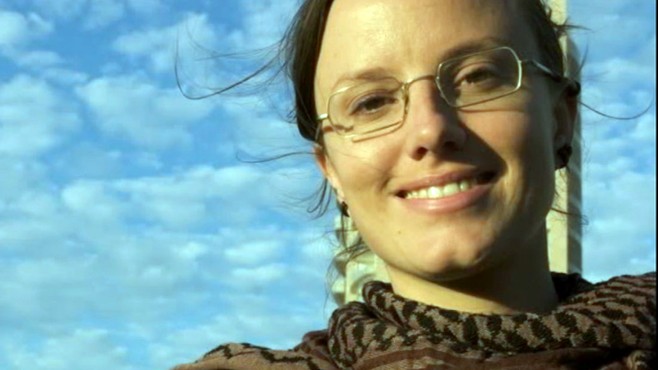Iran Feature: Former Detainee Sarah Shourd "The Plight of Iranians and 3 Decades of US Foreign Policy"
 Sarah Shourd was one of three Americans seized by Iranian security forces in July 2009 as they walked along the Iran-Iraq border. She was held in Evin Prison's Ward 209, where the regime keeps many political prisoners, until her release on a $500,000 guarantee in September 2010.
Sarah Shourd was one of three Americans seized by Iranian security forces in July 2009 as they walked along the Iran-Iraq border. She was held in Evin Prison's Ward 209, where the regime keeps many political prisoners, until her release on a $500,000 guarantee in September 2010.
Writing for The Daily Beast, Shourd reflects on her experience to consider the state of Iran, the spirit of the Iranian people and their ongoing quest for freedom, and the folly of US foreign policy:
When I came out of Iran's Evin prison 16 months ago, one of the first things I did was thank the individuals who were responsible for holding me hostage, having accused me of crossing Iran's border on a hike in 2009. "My gratitude goes in particular to Ayatollah Khamenei and President Ahmadinejad for my compassionate release from detention,” I said, standing behind a podium at a press conference crammed with journalists in New York City. I knew that in the absence of such a statement, my friend Josh.
I assumed I would be widely criticized for my statement of gratitude toward the Iranian government (some observers suggested I had Stockholm Syndrome), but I was mistaken. Iranians around the globe have been especially supportive, sending me hundreds of notes. In one recent message on Facebook, an Iranian woman told me, “Sarah, watching you on TV thanking Ahmadinejad and Khomeini last year, I saw clearly the traces of pain and mental pressure on your young face. Also, I knew you being out with your friends still kept in a cell, you were trapped in a contradictory, paradoxical situation."
The flood of Facebook messages I’ve received from Iranian people since I was released 14 months ago came as somewhat of a surprise at first. In fact, Iranians have been one of our biggest grouping of online support throughout the campaign to "Free the Hikers”. Iranian-Americans have offered us vital support through advice, translation and blogging. Pro-democracy student groups have organized demonstrations and held campus events. When I get stopped in the street or at the airport by a sympathetic, “Sarah, is that YOU?” it is usually an Iranian-American, often with tears in his or her eyes, apologizing for the Iranian government’s actions.
Now that I know more about Iran, it makes perfect sense. Iranians understand what we went through better than anyone else. Their government is rapidly devolving into a neo-totalitarian regime that uses random arrests, assassinations, show trials, and executions to manipulate, silence dissent, and set an example. Many have experienced first-hand having a loved one, neighbor, or friend plucked out of their lives, imprisoned and even killed, sometimes for something as small as writing a blog.
The incredible thing for me was that so many Iranians worldwide took the time to care about us despite the thousands of other political prisoners they have to worry about. “I'm an Iranian boy ashamed for what our government did to three American hikers,” another message on Facebook says. “I want you to know Iranian people are with you and against their own government. Iran's regime is not chosen by Iranian people. They kill and torture us and we are all in a very big prison named Iran.”
I did not intentionally walk across an unmarked border into a country whose language I didn’t speak and history I'd never studied. Nor did I choose the most interesting and volatile time in the Islamic Republic's 31-year history to be captured, imprisoned, and psychologically tortured by the government. But it happened. Like a lot of the world, I was just beginning to wake up and pay attention to Iran in the weeks leading up to my captivity. The post-election protests were all over the news, and I was intrigued by what felt like a new breed of a nonviolent mass movement, with powerful use of imagery, props, and tactics. Call it fate or call it coincidence, even though I never intended to go anywhere near Iran, I found myself thrown into a small cell in Evin prison, while the Green Movement was raging in the streets.
Iran’s movement for democracy, freedom, and human rights did not spring out of nothing after the disputed elections of 2009. It has been a slow, burning fire in the hearts of Iranians for decades, some say since Iran’s first democratically elected prime minister, Mohammed Mossadegh, was deposed by a CIA-orchestrated coup in 1953. Others attribute the birth of the movement to 1979, when the Shah was overthrown by popular uprising and an Islamic Republic emerged with power concentrated in the “Supreme Leader." Iranians are extraordinarily cognizant of their own history, and they don’t want to repeat it by installing another U.S. puppet like the Shah; nor can they continue to tolerate rampant human-rights abuses and despotism in the name of Islam. The millions of people who took to the streets after the disputed 2009 elections want to get outside of history. They are seeking a third, nonbinary way, based on a common vision instead of a common enemy. For 31 years, “Death to America” has been chanted in the streets of Tehran. In 2009 a new cry, “Death to No One,” was born.

 Wednesday, December 28, 2011 at 8:41
Wednesday, December 28, 2011 at 8:41
Reader Comments